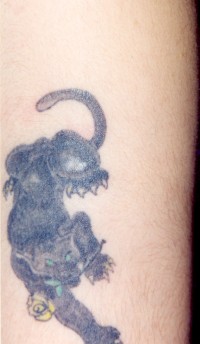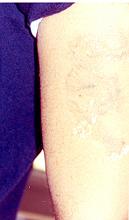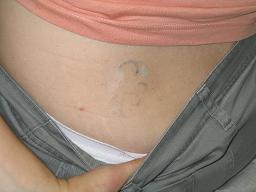|
|
||||||||||||||||
|
Tattoo Removal Methods |
||||||||||||||||
|
||||||||||||||||
How does the Midlite laser remove tattoos? |
||||||||||||||||
| The Midlite laser system removes tattoo ink with the energy of light. Just as natural sunlight is made up of light wavelengths of many colors, a laser is a device which is designed to produce one or more specific wavelengths of light. Tattoo ink is removed by using a specific wavelength which passes through the skin but is absorbed by the ink. The tattoo ink absorbs the light and shatters the ink into tiny fragments small enough to be engulfed by the body’s natural defense cells (Macrophages), which in turn are carried away and removed by the immune system of the body. The real tattoo removal begins after the laser treatment. The laser does not remove anything; it merely disrupts the tattoo pigment. It is the body's own immune system that carries the pigment away, resulting in the fading of the tattoo. Medical research has taught us which wavelengths of light to use and specifically how to deliver them to best remove tattoo ink. The greater the absorption of the laser light, the greater the energy available to break up the pigment:
|
||||||||||||||||
The actual absorption of a given tattoo ink may vary considerably depending on the particular pigments in the ink, which are usually not known to the patient, tattoo artist, or the treating doctor. Also, the chemical pigments may undergo chemical changes after treatment. These factors often leads to variable and or inconsistent responses of a give color to a given laser wavelength. Currently there are four different Q-Switched lasers available for tattoo removal:
|
||||||||||||||||
Who is a Candidate? |
||||||||||||||||
| Anyone with an undesired tattoo is a candidate for laser tattoo removal. Most tattoo colors can be eliminated or lightened to a large degree. Good candidates for tattoo removal without scarring are those with medium to fair skin, dark but not dense ink, and a superficial ink depth. The preferred locations include arms, chest, buttocks, and anywhere else on the body with good circulation. Medium- or fair-skinned patients react well because the light will be able to selectively target the ink instead of the dark skin. Dark ink that is not dense is favorable because the light is more attracted to darker colors so darker ink is fragmented better than yellow ink. Density is also a factor; the more ink, the more there is to fade. Superficial ink is also favorable because it is closest to the surface of the skin so the laser doesn't need to penetrate so many skin layers to get to it. Results are quicker. Areas such as the arm or chest have more blood flow and are a better vehicle for the immune system which is what removes the ink. Areas such as the ankle or fingers have poor circulation and are tougher to treat. Skin colored tattoos may undergo irreversible ink darkening. This is seen with some white, pink, flesh-toned and light brown tattoo inks. Red ink tattoos may turn black. Tattoos may be improved with subsequent laser treatments. Patients with previously treated tattoos may also be candidates for laser therapy. Tattoos that have not been effectively removed by other treatments or through home remedies may respond well to laser therapy providing the prior treatments did not result in excessive scarring. |
||||||||||||||||
How Many Treatments Are Needed? |
||||||||||||||||
| Each tattoo has different characteristics that influence the number of treatment sessions necessary. These include: Size, Color, Type of ink used, Whether the tattoo is old or new, and Type of the tattoo. The color, depth, density of the ink are probably the biggest determining factors involved in successfully removing a tattoo. In addition, professional tattoos require more treatments while amateur and cosmetic tattoos require less. Most tattoos are comprised of different colors. Some tattoos can require between 15 and 20 treatments before they are completely removed. In most cases, laser tattoo removal takes between six and twelve treatments spaced at 6 - 8 weeks apart but can be spread over several months or a few years. The laser tattoo removal treatment may last anywhere from 10-30 minutes depending on the tattoo size. As a general rule, "modern" (Less than 10-15 years old) tattoos on the trunk tend to clear with fewer treatments than older tattoos or tattoos on the arms and leg. |
||||||||||||||||
Do all colors disappear equally as well? |
||||||||||||||||
| No. Dark (blue/black) inks and red inks fade the best. Oranges and purple usually respond well. Green and yellow inks are the most difficult to remove, although additional treatments can produce significant fading. Turquoise tattoos are some of the most difficult to eliminate because there isn’t a laser that targets the color effectively.
|
||||||||||||||||
Is the laser tattoo removal safe and will the Tattoo completely disappears? |
||||||||||||||||
|
Thanks to newer technology, treatment of tattoos with laser systems has become much more effective with very little risk of scarring or side effects. Laser treatment is non invasive and only targets the ink used in the tattoo. In many cases the tattoo disappear completely. Greater than 95% fading of the tattoo may be accomplished. However, it is very important to know that over 100 ink tattoo inks are in use worldwide today, none of which are regulated by the FDA. Not knowing which tattoo ink, how deep or how much was used, makes it impossible for the physician to predict the degree of removal on any given tattoo. |
||||||||||||||||
Is the treatment Painful? |
||||||||||||||||
| The unfortunate thing about tattoos is that both getting them and having them taken off can be uncomfortable. The impact of the energy from the laser's powerful pulse of light has been described as similar to being snapped by a thin rubber band. The application of a prescription anesthetic cream one to two hours before the laser session will markedly reduce the pain. It is wiped off just before laser surgery begins. Others prefer to have a local anesthetic injected into the tattoo prior to laser therapy. | ||||||||||||||||
What to expect after the Treatments and what are the side effects? |
||||||||||||||||
| Recovery time is very short and specific instructions regarding care of the area will be provided. Pinpoint bleeding is sometimes associated with the procedure. Following treatment, an antibacterial ointment and dressing will be applied to the area, which should be kept clean with continued application of ointment as directed. A shower or bath the day after treatment is okay, but the treated area should not be scrubbed. Your skin might feel slightly sunburned for a couple of days and the treated area may remain red for a few weeks. Immediately after a treatment, you can apply an ice pack. The site might also form a scab, which should be handled gently. After healing, the site will gradually and continually fade. There are no major side effects associated with laser treatment but hyper pigmentation (an abundance of skin color at the treated site) or hypo pigmentation (treated area lacks normal skin color) may occur. There are chances of infection of the site. Occasionally mild changes in skin texture may occur. In some cases, the tattoo may not be removed completely and the patient may form permanent scars also, though this is rare. Darker tattoos are easier to remove in light skinned people. This is so because, lasers are designed to differentiate between skin pigment and tattoo ink. Also, the best areas from which tattoos can be removed easily are those areas of the body with good circulation, such as arms and chest. Cosmetic tattoos like lip liner, eyeliner and eyebrows may darken following treatment with tattoo removal lasers. Further treatment of the darkened tattoos usually results in fading. |
||||||||||||||||
|
||||||||||||||||
How Much Does it Cost? |
||||||||||||||||
| Getting a tattoo removed is much more expensive than having one put on. Price depends upon the size, type and location of the tattoo and the number of visits required. Cost range between $200 - $800 per session, as an average. If your tattoo is extensive, expect to pay more. For specific information about your tattoo(s), a consultation would be required. During the consultation the tattoo(s) can be evaluated, all questions can be answered, risks and benefits covered, as well as establishing a price per treatment & approximate number of treatments needed. Consultations are available on Monday, Tuesday, Thursday and Friday only with appointment. Saturday appointments are occasionally available only. The consultation fee is $50, which may be credited towards the first treatment if done within 30 days of the consult for qualified candidates. |
||||||||||||||||
Does Insurance Cover Laser Tattoo Removal? |
||||||||||||||||
| Since tattoo removal is a personal option in most cases and is considered a cosmetic procedure, insurance carriers will not cover the process. Payment in full on the day of the procedure is required. Remember, the information provided here is designed to provide general information only and is not a replacement for a physician's advice. For details pertaining to your specific case, please arrange a consultation with a physician experienced in the use of tattoo lasers. | ||||||||||||||||
If you have a tattoo or other skin blemish that you would like removed,call the Vein & Laser Center to arrange for private laser consultation at 201-795-9007. |
||||||||||||||||




